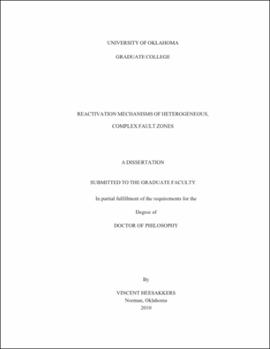| dc.contributor.advisor | Reches, Ze'ev | |
| dc.creator | Heesakkers, Vincent | |
| dc.date.accessioned | 2019-04-27T21:28:45Z | |
| dc.date.available | 2019-04-27T21:28:45Z | |
| dc.date.issued | 2010 | |
| dc.identifier | 99225369502042 | |
| dc.identifier.uri | https://hdl.handle.net/11244/318787 | |
| dc.description.abstract | Fault reactivation occurs on a short-term cycle of tens to thousands of years between infrequent earthquakes, and on long-term cycles of fault inactivity for 106 - 107 years. During long-term cycles, faults may heal and renew their strength. The objective of the present work is to study the mechanisms of fault reactivation after a long dormant period, when the pre-existing fault is not necessarily "weak". | |
| dc.description.abstract | The study is conducted along the Pretorius fault, TauTona mine, South Africa. The deep gold mines in South Africa provide access to earthquake processes at focal depth, which was motivation for the NELSAM (Natural Earthquake Laboratory in South African Mines) project to develop an underground earthquake laboratory at ~3.5 km depth within TauTona mine (Ch. 1). The present study is conducted within the NELSAM site that includes the 2.7 Ga Pretorius fault, which has been inactive for at least 2.0 Ga and is currently being reactivated due to nearby mining activity. I characterize the fault zone by 3D underground mapping within mining tunnels at 3.6 km depth (Ch. 2). The structural analysis is accompanied by fracture analysis from borehole image logs and micro-structural studies. I find that the Pretorius fault is structurally complex, with a 20-30 m wide zone of anastomosing, dominantly steep fault segments that contain a strong cohesive sintered cataclasite. Despite the size of the Pretorius fault, a few km long with ~200m horizontal and 30-60 m vertical displacement, its complexity reflects the fault zone immaturity. | |
| dc.description.abstract | The exposed rupture zone of the M2.2 of December 12, 2004, was mapped in detail at focal depth (Ch. 3). It reactivated three to four quasi-planar, non-parallel segments of the Pretorius fault, with characteristic generation of fresh fine grained rock powder along the contact of the quartzitic host rock and the cataclasite, indicating localization of slip during the event. To investigate the mechanism responsible for such localization, rock mechanics experiments were conducted on cataclasite and quartzite samples within the fault zone. The results show a mechanical contrast between the quartzite, that show significant strain hardening due to dilation of micro-cracks, and the weaker but more brittle cataclasite. A finite element analysis suggest that this mechanical heterogeneity effectively controls the localization of shear strain at the contact, similar to the observations of the M2.2 rupture and rock mechanics experiments. | |
| dc.description.abstract | The stresses associated with the M2.2 rupture are calculated from in-situ stress measurements on borehole failures of three boreholes within 60 m from the exposed rupture (Ch. 4). The calculations, combined with the geometry of the rupture zone, suggest that slip during the M2.2 occurred under low shear stress. It is likely that stress interaction between the reactivated segments, and dynamic weakening due to gouge formation and lubrication allowed such slip. The earthquake energy balance of the event is estimated by combining field observations and stress measurements with the seismic signal. It appears that the fracture energy cannot be ignored and contributes for ~ 1/3 to the total energy, similar to the frictional heat energy contribution. | |
| dc.description.abstract | The unique setting provided an extraordinary data set of a single earthquake with field observations at focal depth, rock mechanics, rupture-associated stresses and seismic signal. The results describe reactivation processes in detail and contribute to the understanding of earthquake mechanisms. | |
| dc.format.extent | 178 pages | |
| dc.format.medium | application.pdf | |
| dc.language | en_US | |
| dc.relation.requires | Adobe Acrobat Reader | |
| dc.subject | Faults (Geology)--South Africa | |
| dc.subject | Earthquakes--South Africa | |
| dc.title | Reactivation Mechanisms of Heterogeneous, Complex Fault Zones | |
| dc.type | text | |
| dc.type | document | |
| dc.thesis.degree | Ph.D. | |
| ou.group | Mewbourne College of Earth and Energy::ConocoPhillips School of Geology and Geophysics | |
